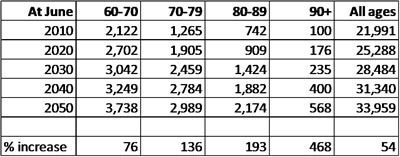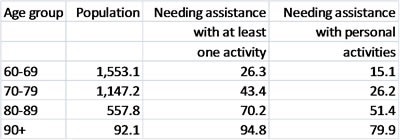Mar 9 2011
 By Dr Kim Sweeney
By Dr Kim Sweeney
Centre for Strategic Economic Studies, Victoria University
Background
There are a number of studies that look at the economics of technologies to enable people to age at home rather than in some other kind of accommodation. In 2010, CSES contributed an economic analysis for the ATSE report written by Greg Tegart drawing in part on these studies and using Australian data on demographic trends and healthcare costs.
Review of assistive technologies
In their review1 of assistive technologies for older people for the Department of Health and Ageing in June 2008, Urbis found that;
- “High quality evidence which establishes the effectiveness of assistive technology is not prolific”, but that,
- “there is strong evidence that assistive technologies can enable: improved safety and reduced falls; reduced hospitalisation; improved independence, mobility and physical function; improved well-being and quality of life, including an enhanced sense of safety and increased opportunities to continue living at home”.
- However “there is remarkably little material that explores the use and effectiveness of assistive technologies in Australia”.
- They concluded that “evidence about the cost-effectiveness of assistive technology is still in the early stages. However the potential cost savings of assistive technology indicated by this preliminary research are considerable.”
Urbis found that most effective assistive technologies include:
- Aids, devices and equipment to improve ease of living, safety and physical function.
- Environmental adaptations to the home, including adjusting benches, installing ramps and removing hazards.
- Telecare and smart technologies to improve overall ‘peace of mind’ for older people and carers to improve safety and reduce hospitalisation and to improve quality of life and opportunities to remain at home, deferring the need to move into residential care.
Demographic analysis for ATSE study
According to ABS projections of population through to 2050 the numbers of older people in the population will grow faster than other age groups.

ABS 2008, Population Projections, Australia, 2006 to 2100,
Cat No 3222.0, Canberra, 2008
In terms of population shares, older people will be about 28% of the population in 2050, up from 19% in 2010.

ABS 2008, Population Projections, Australia, 2006 to 2100,
Cat No 3222.0, Canberra, 2008
In 2003 the ABS estimated the percentage of people requiring assistance with personal activities. Of these people some 18.1% were in care rather than at home.

ABS 2004, Disability, Ageing and Carers: Summary of Findings,
Australia, ABS Cat No 4430.0, Canberra, 2004
Using these percentages we can project the future numbers of people requiring assistance with personal activities as follows.

And the projected number of people in care as follows.

Case studies in ATSE study
A number of case studies were examined, including
- “Apartments for Life “ – Benevolent Society proposal for accommodation complex in Bondi
- Dementia study by Access Economics
- US Department of Veterans Affairs home telehealth program
- West Lothian Smart Technology and Community Care
West Lothian Smart Technology project
In 1999 the West Lothian Council in Scotland introduced its ‘Opening Doors for Older People’ initiative in order to, “provide an innovative form of housing for older people with support needs that will sustain independent living through effective physical design, focused individual care planning and the efficient use of new technologies.” They offered technology packages for existing homes and built new facilities incorporating these technologies. An evaluation2 was carried out by the University of Stirling in 2006 and reported good satisfaction from stakeholders.
The evaluation reported good satisfaction among older people, carers and other stakeholders, and that the program “appeared capable of supporting people with dementia to age in place”. They found that the average weekly cost of care in existing homes where technologies were installed or in newly built homes was significantly less than for residential care.
The review reported the following costs for different types of residence.

The difference in cost between residential care and the purpose built new facilities was £9,620 per person per year, or A$15,516.
Potential savings in Australia
The ATSE study estimated the annual savings to Government from a reduction in the number of people in residential care due to the introduction of assistive technologies.
The main programs providing assistance to older people needing care are;
- Home and Community Care (HACC)
- Community Aged Care Packages (CACP)
- Extended Aged Care at Home (EACH)
- EACH Dementia (EACHD)
- plus DVA Veterans Home Care
The estimated cost per person for these programs in 2008-09 was as follows:

If 10% of the 157,000 persons in permanent residential care in Australia in 2008-09 were cared for by these other programs the savings to the Government would be as follows.

The ATSE study also estimated the savings to Government from the use of technology in the home to reduce the number of falls among the elderly. If 10% of the current number of falls could be avoided this would reduce the annual cost of hospitalisation from this cause by about $85 million.
PC inquiry on aged care
In January, the Productivity Commission released its draft report on Caring for Older Australians. The inquiry is to “develop regulatory and funding options… for aged care… that, …support independence, social participation and social inclusion, including… policy, services and infrastructure that support older people remaining in their own homes longer …”
The Draft Report has little to say on the role of technology in meeting these objectives, other than a discussion in Chapter 10 about design and building standards.
ATSE has recommended that the PC undertake a study of the potential savings arising from the use of smart technologies to enable ageing-in-place, and the development of new health funding models to support deployment of these technologies.
1. Connell J, Grealy C, Olver, K and Power J 2008, Comprehensive scoping study on the use of assistive technology by frail older people living in the community, Urbis for the Department of Health and Ageing.
2. Bowes Alison and Gillian McColgan, Smart technology and community care for older people: innovation in West Lothian, Scotland, Department of Applied Social Science, University of Stirling, August 2006